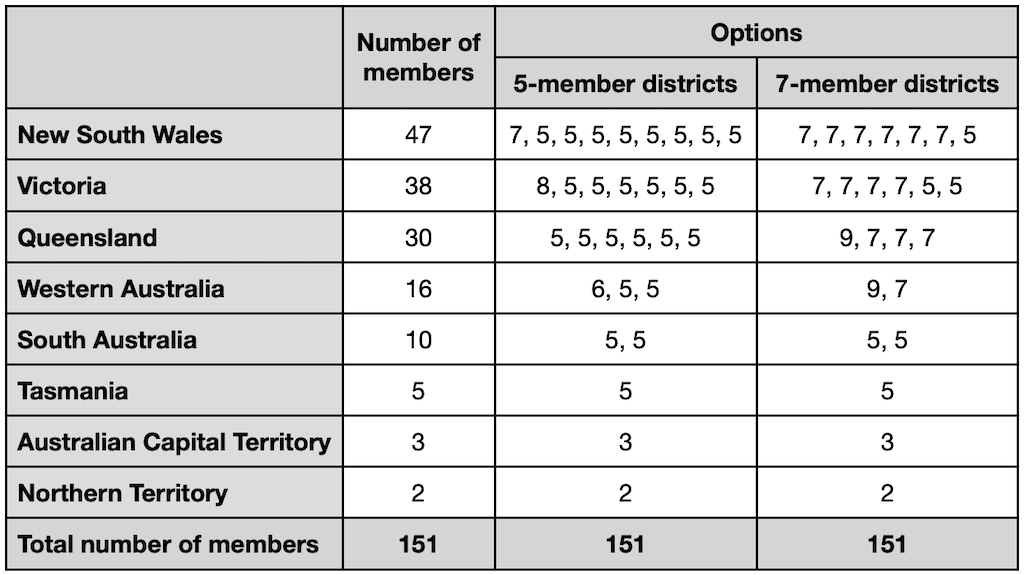Introduction
The House of Representatives is Australia’s lower house. Deficiencies in the present electoral system include:
- 1-member electoral districts (instead of multi-member)
- Casual vacancies filled by by-election (instead of countback).
PRSA policy
The following text has been adopted as PRSA policy:
Summary: Members should be directly elected using multi-member electoral districts and the single transferable vote form of proportional representation, with no exclusionary threshold applying. The voting and counting systems should closely resemble the Hare-Clark systems used in Tasmania and the Australian Capital Territory, but with the transfer values described below.
House of Representatives structure: The Speaker should continue to have a casting vote only, and not have both a deliberative vote and a casting vote.
Multi-member electoral districts: Members should be elected from multi-member districts. State districts should each return at least 5 members. District magnitude should vary as little as practicable within each State, and between States. Each member should represent the same number of voters, and the ratio of voters to members should be within a range of plus or minus ten per cent of the Federation’s average enrolment per member. If the number of members to be returned from a State requires that State to use one or more districts returning a different number of members from other districts, then the district returning the largest number of members should be located at the centre of the city with the largest population (to minimise boundary changes during redistributions).
Neutral ballot-paper format: Voters should be provided with as clear and simple a ballot paper format as practicable, and it should be similar to the format presently used for elections to Tasmania’s House of Assembly. No Group Voting Ticket, or associated above-the-line voting option should be provided for, and voters should be required to explicitly mark a preference for each candidate they vote for. A ballot paper statement should advise voters to mark at least as many preferences as there are vacancies, and encourage them to mark as many further preferences as they see fit, but a ballot should be formal if it is marked with a unique first preference. Candidates should be listed in columns, with the names of candidates rotated in different positions within each column, using Robson Rotation. Ideally, Robson Rotation should also apply to the order of the columns from left to right across the ballot paper.
One vote, one value: In the rules for counting votes, transfer values should be determined using the Weighted Inclusive Gregory Transfer method presently used for the transfer of surplus votes for Western Australia’s Legislative Council; or the Meek method prescribed in Schedule 1A of New Zealand’s Local Electoral Regulations 2001.
Direct election of all members: Casual vacancies should be filled using the countback system, with Tasmania’s contingency provision for a by-election poll if necessary.
This PRSA Policy (PRSA-002) was adopted at a postal ballot of PRSA members on 17th September 2019.
Discussion
Compared with the existing House of Representatives electoral system, the above policy proposes the following changes:
- Change from 1-member districts to multi-member districts, to deliver a far more proportional and representative result
- Use countback to fill casual vacancies, to ensure all representatives are elected by the preferences of voters
- Use fully optional preferential voting, to provide maximum flexibility to voters to indicate their preferences
- Use Robson Rotation within columns and for the order of columns, to offer each candidate an equal opportunity to attract votes
- Improve the method of counting votes and determining transfer values, to ensure ‘one vote, one value’
Examples
The policy allows for multiple possible electoral system designs, including:
- Preferentially 5-member districts, with a single supplementary district that can range from 5 to 9.
- Preferentially 7-member districts, with the allocation of district magnitudes following a defined set of rules.
The table below shows how districts in each State & Territory could be allocated for the above options:

